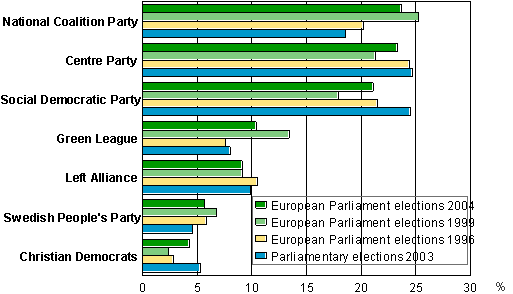14 June 2004
Inquiries: Ms Eeva Heinonen +358 9 1734 3268
Director in charge: Ms Riitta Harala
Voting turnout rose higher than in the previous elections
Voting turnout in the European Parliament elections was 41.1 per cent. Voting turnout rose in the whole country by 9.7 percentage points compared with the European Parliament elections 1999. Now the number of voters was over 400,000 higher than in 1999.
Voting turnout rose in the whole country but it grew more than average in the constituencies of Southern Finland (by over 11 percentage points) and Vaasa (by more than 10 percentage points). Voting turnout was highest in the constituency of Helsinki, where it rose to 52.2 per cent. The second best voting turnout, 45.8 per cent, was attained in the constituency of Uusimaa. The voting turnout of 40 per cent was also exceeded in the constituencies of Vaasa (44.4%) and Varsinais-Suomi (41.6%). Voting was least active in the constituencies of North Karelia (32.7%) and North Savo (34.5%). Of individual municipalities, voting turnout was highest in the country in Kauniainen (69.1%) and lowest in the municipality of Rautavaara (24.7%).
Over two thirds of the votes to the National Coalition Party, Centre Party and Social Democratic Party
The National Coalition Party, Centre Party and Social Democratic Party gained altogether 11 of the 14 seats allocated to Finland and retained their previous seats in the European Parliament. The Centre Party and National Coalition Party both gained four seats and the Social Democratic Party three. The Left Alliance and the Swedish People's Party in Finland also retained their former positions, both gaining again one MEP. Finland's loss of two seats in the European Parliament resulted in the defeat of the Green League and Christian Democrats in Finland. The Green League now has only one MEP, thus losing their other seat in the European Parliament and the Christian Democrats failed to keep the one seat they gained in the previous elections.
Finland's representatives are divided in the European Parliament into the following groups:
- Four MEPs of the National Coalition Party to the Conservatives (PPE-DE)
- Four MEPs of the Centre Party and one MEP of the Swedish People's Party to the Liberals (ELDR)
- Three MEPs of the Social Democratic Party to the Socialists (PSE)
- One MEP of the Green League to the Greens (Verts/ALE)
- One MEP of the Left Alliance to the Left-wing group (GUE/NGL)
Votes cast for the major parties in European Parliament elections 2004, 1999 and 1996 and in Parliamentary elections 2003, %

Votes cast for the major parties in European Parliament elections 2004, 1999 and 1996 and in Parliamentary elections 2003, %
>
| European elections | European elections | European elections | Parliamentary elections. | |
| 2004 | 1999 | 1996 | 2003 | |
| National Coalition Party | 23.7 | 25.3 | 20.2 | 18.6 |
| Centre Party | 23.3 | 21.3 | 24.4 | 24.7 |
| Social Democratic Party | 21.1 | 17.9 | 21.5 | 24.5 |
| Green League | 10.4 | 13.4 | 7.6 | 8.0 |
| Left Alliance | 9.1 | 9.1 | 10.5 | 9.9 |
| Swedish People's Party | 5.7 | 6.8 | 5.8 | 4.6 |
| Christian Democrats | 4.3 | 2.4 | 2.8 | 5.3 |
Further information from Statistics Finland's
Internet service:
http://tilastokeskus.fi/tk/he/vaalit/index_en.html
http://tilastokeskus.fi/tk/he/vaalit/vaalit2004eur/index_en.html
Source: Statistics Finland's election statistics
